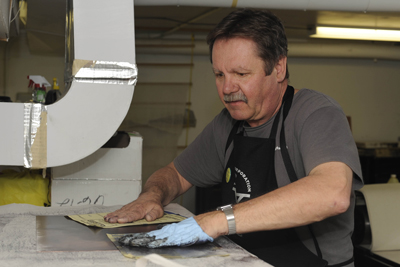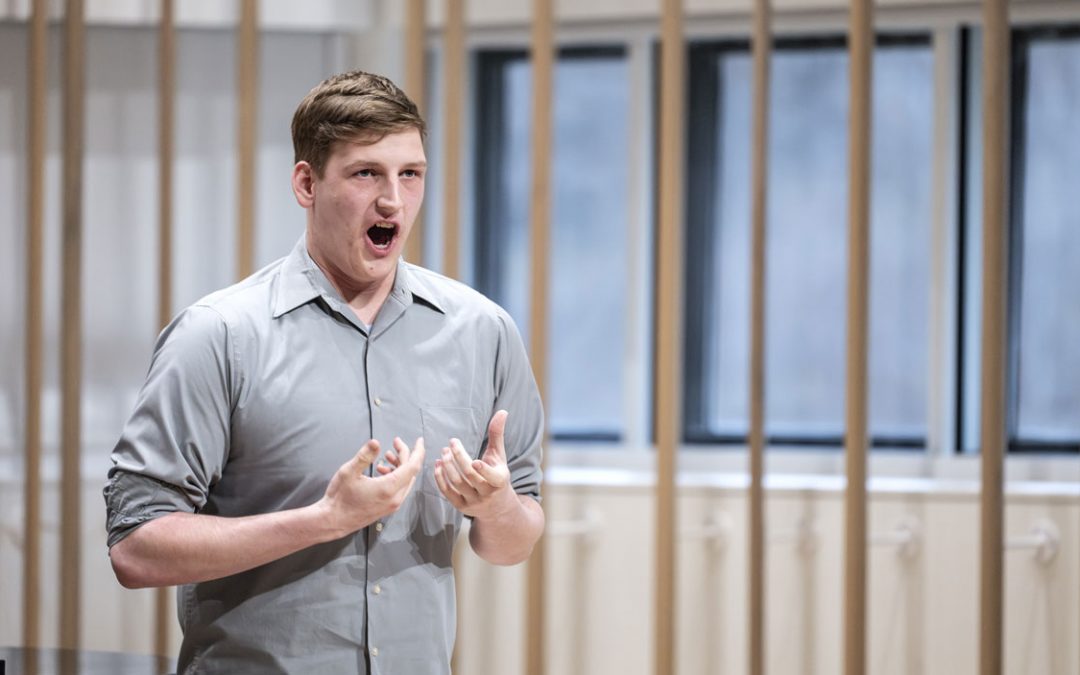
Jeff Sippel, associate professor of art at UMSL, prepares an etching plate for printing by applying ink to a copper plate at the Kinngait Studio in Cape Dorset, Canada. The resulting prints have an appearance similar to a watercolor painting.
Jeff Sippel’s lithography skills have taken him all over the world. But the associate professor of art at the University of Missouri–St. Louis described coming home last month from his most recent residency – in Cape Dorset, Canada – “like returning from the moon.”
Cape Dorset is an Inuit hamlet on the diminutive Dorset Island off the southwestern tip of the much bigger Baffin Island – both part of the immense and relatively remote Nunavut, the northernmost Canadian territory. The fur trade once drove the community’s economy, but Cape Dorset became known as “the capital of Inuit art” after the mid-20th century arrival of writer and artist James A. Houston.
Houston taught the natives printmaking, assisted them in their creation of a profitable artist cooperative and introduced the world to the Inuit artists’ prints and sculpture through marketing and museum exhibits. The New York Times reported that the Inuit art trade is today worth more than $10 million annually.
Sippel came to be involved in Cape Dorset earlier this spring through an invite from his former student Bill Ritchie, who now oversees the West Baffin Eskimo Co-op. This spring, Sippel spent a little over a fortnight there creating prints and teaching new techniques to the artists.
“It was an amazing experience and so neat to work with co-op’s printers,” he said.
The artist community was unlike any Sippel had ever encountered. Despite Cape Dorset’s isolation from Canada’s more populous cities, he said Kinngait Studio was one of the best equipped he’d ever seen. And then there were the co-op artists.
Sippel described them as being like technicians. They came to work each day at 9 a.m., churned out new art between coffee and lunch breaks and clocked out at 5 p.m.
“I know of no other culture, where someone can create works of art and receive payment immediately after execution,” he recalled “I witnessed many artists completing works and receiving a ‘check’ from the Co-op upon delivery to Kinngait Studios.”
What they didn’t do, he said, is experiment much with new styles and concepts.
“They know what to do and they do it well; they just don’t go off the beaten path,” Sippel said. “Bill is trying to introduce them to more contemporary approaches. But there are a couple of problems with that – getting the artists to do it and getting the public to accept it because they typically want the traditional Inuit art.”
Still, Sippel said he believed he opened some eyes.And the experience was enriching for him too. In working closely with the artists, he got to see how they generated ideas.
“New encounters with other aritsts and new surroundings have a direct influence on all artists,” he said
He also marveled in the novelties that come with a secluded art-driven Arctic community.
First, there was the food. Sippel could go local by noshing on raw seal and caribou like James A. Houston subsided on. Instead, he opted for the pricier flown-in fare, which typically flew off the shelves despite not-so-bargain prices like $3 for an avocado or $24 for a 12-pack of Pepsi. He also indulged in a hamburger at the local café one night – another luxury Houston didn’t have.
It was also cold in Cape Dorset. Extremely cold.
Sippel recalled how, after taking in a pickup game of hockey, it felt as though the slightest breeze made his nose as frozen as the snow-covered ground along the short, two-block walk back to his apartment. And yet, it wasn’t unusual to see co-op artists outside working on a sculpture.
“I wanted to go in the summertime when it was warmer, but the printers don’t work in the summer,” Sippel said. “They stop creating art to do all their hunting for the year.”
Sippel’s expertise in traditional lithography and waterless lithography has led to him lecturing and leading workshops on every continent but Australia and Antarctica. Last year, for example, he spent the month of February at the Universiti Sains Malaysia and more than a week at Arts University in Aguascalientes, Mexico. But Cape Dorset will always stand out to him.
“It’s just such an unusual place in that it’s the most unlikely locale you’d think of to find an operation like the artist cooperative there,” Sippel said.
He added, “The artwork created by them is derived so much from the heart. This is so unique, bacause they basically, have no external influences.”
More information:
umsl.edu/~art/bios/sippel.html
dorsetfinearts.com














